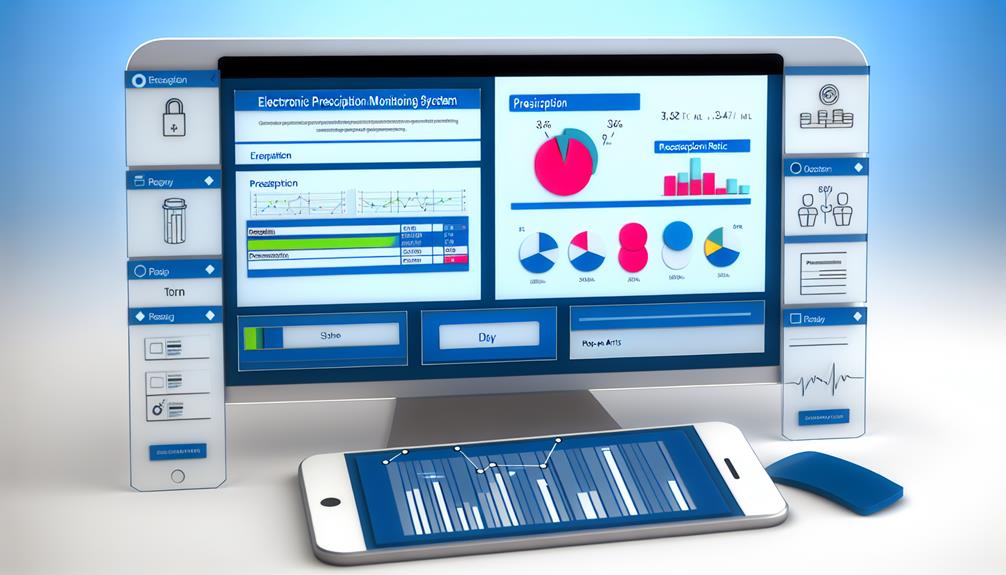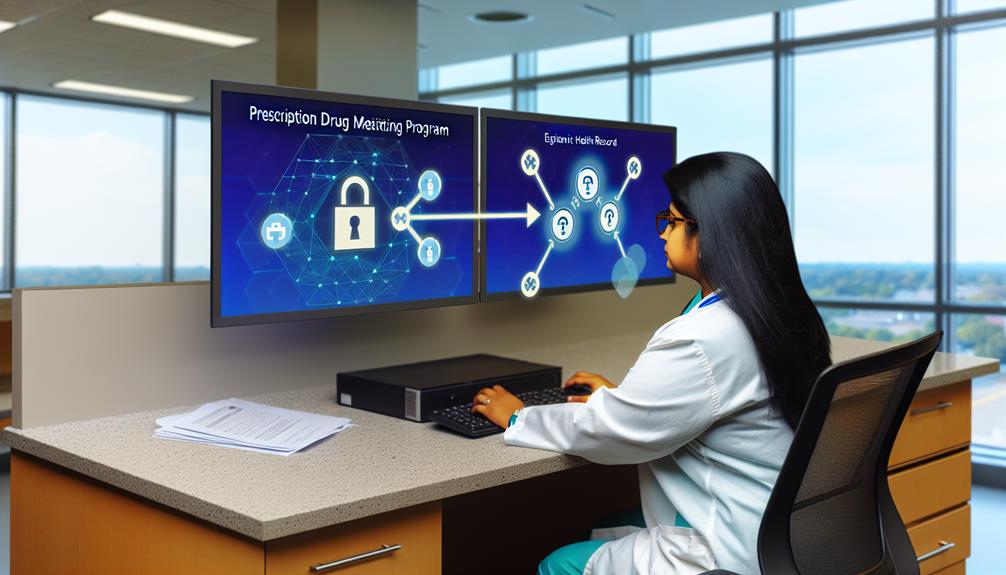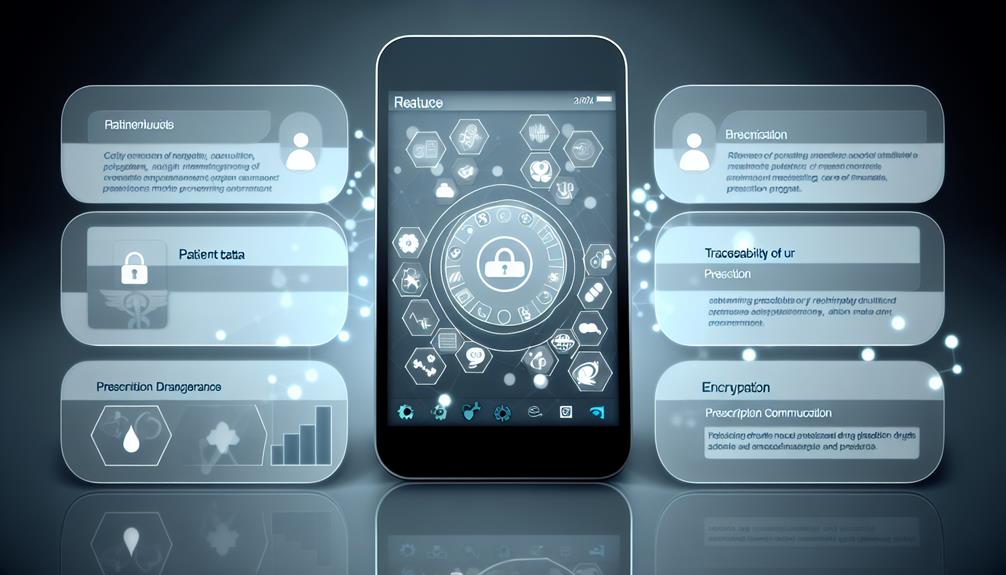Coincidentally, as you navigate the complex landscape of prescription drug monitoring programs, you may be wondering what technology lies at the heart of these essential systems.
Well, look no further, because in this discussion we will explore the various technological advancements that support the seamless operation of prescription drug monitoring programs.
From electronic prescription monitoring systems to data analytics and reporting tools, the integration with electronic health records, and even mobile applications for healthcare providers, there is a plethora of innovative solutions that play a crucial role in ensuring the safety and effectiveness of prescription drug monitoring.
So, without further ado, let's dive into the world of technology that powers these programs and discover how they are transforming the healthcare industry.
Electronic Prescription Monitoring Systems

Electronic prescription monitoring systems are essential tools used to track and monitor the dispensing and use of prescription drugs, providing detailed and accurate data for effective oversight and control. These systems play a crucial role in ensuring regulatory compliance requirements are met while addressing patient privacy concerns.
To meet regulatory compliance requirements, electronic prescription monitoring systems are designed to capture and store data related to prescription drug dispensing. This includes information such as the prescribing physician, the patient's details, the medication prescribed, and the quantity dispensed. By collecting this data in real-time, these systems allow authorities to monitor and analyze prescription drug usage patterns, identify potential cases of abuse or diversion, and take appropriate action.
Patient privacy concerns are of utmost importance in the healthcare industry, and electronic prescription monitoring systems take these concerns into account. They're built with robust security measures to protect patient data from unauthorized access or disclosure. Encryption techniques are used to secure the data during transmission and storage, and access to the system is limited to authorized personnel only. Additionally, strict protocols are in place to ensure that patient information is used solely for monitoring and regulatory purposes, with strict penalties for any misuse.
Data Analytics and Reporting Tools
Data analytics and reporting tools enable organizations to effectively analyze and present the data collected by electronic prescription monitoring systems, providing valuable insights for regulatory oversight and decision-making. These tools play a crucial role in harnessing the vast amount of data generated by prescription drug monitoring programs (PDMPs) and transforming it into actionable information.
Data visualization is a key component of these tools, allowing users to visually explore and understand the data. Through interactive charts, graphs, and maps, stakeholders can easily identify patterns, trends, and outliers in prescription drug data. This visual representation enhances comprehension and facilitates communication of complex information.
Predictive analytics is another important feature of data analytics and reporting tools. By leveraging historical data, these tools can forecast future trends, identify potential risks, and inform proactive interventions. For example, predictive analytics can help detect patterns of misuse or abuse, identify high-risk patients, and support targeted interventions to improve patient outcomes and public health.
In addition to data visualization and predictive analytics, these tools also offer robust reporting capabilities. They allow organizations to generate comprehensive reports summarizing key metrics and trends, facilitating regulatory oversight and decision-making processes. These reports can be customized to meet specific needs and requirements, ensuring that the right information is delivered to the right stakeholders at the right time.
Integration With Electronic Health Records

To further enhance the effectiveness of prescription drug monitoring programs (PDMPs), the integration of electronic health records (EHRs) becomes imperative, allowing for seamless access and exchange of crucial patient information. However, integrating PDMPs with EHRs presents several interoperability challenges.
One major challenge is the lack of standardized data formats and protocols across various EHR systems. This makes it difficult for PDMPs to effectively retrieve and analyze data from different EHR sources.
Another challenge is the varying levels of EHR adoption among healthcare providers. While some providers have fully implemented EHR systems, others still rely on paper-based records or outdated electronic systems. This diversity in technology infrastructure creates barriers to the smooth integration of PDMPs with EHRs.
Despite these challenges, the integration of PDMPs with EHRs has the potential to greatly impact patient privacy. EHR systems contain highly sensitive patient information, such as medical history, diagnoses, and medications. Therefore, it's crucial to ensure that the integration process is secure and follows strict privacy protocols. Unauthorized access to PDMP data through EHRs could compromise patient confidentiality and lead to potential misuse of sensitive information.
Prescription Drug Database Management
Managing prescription drug databases is a critical aspect of ensuring the effectiveness and functionality of prescription drug monitoring programs (PDMPs). Prescription drug tracking and abuse prevention are key components of these databases.
The primary goal of prescription drug database management is to collect, store, and analyze data related to prescription drug dispensing and utilization. This allows healthcare providers, pharmacists, and law enforcement agencies to monitor and detect potential instances of prescription drug abuse and diversion.
Prescription drug databases are designed to capture and store information such as patient demographics, prescriber details, and dispensed medication data. This information can then be used to identify patterns, trends, and potential red flags related to prescription drug abuse and misuse.
Database management systems also enable real-time monitoring and reporting, allowing for timely interventions and interventions when necessary.
To effectively manage prescription drug databases, advanced technology systems are employed. These systems utilize secure and reliable databases, capable of handling large volumes of data. They also incorporate sophisticated algorithms and analytics tools to identify patterns and anomalies within the data.
Additionally, data integration capabilities are crucial for seamless sharing of information between healthcare providers, pharmacies, and law enforcement agencies.
Mobile Applications for Healthcare Providers

Mobile applications provide healthcare providers with convenient and efficient tools for accessing and managing prescription drug information. These applications are designed to be used on smartphones and tablets, allowing healthcare providers to access patient records, view prescription histories, and monitor medication adherence on the go. In addition, mobile applications can integrate with telemedicine platforms, enabling healthcare providers to communicate with patients remotely and prescribe medications electronically.
One key advantage of mobile applications for healthcare providers is the ability to engage patients in their own care. These applications can send medication reminders, provide educational materials about prescribed drugs, and allow patients to track their own medication usage. By promoting patient engagement, mobile applications can help improve medication adherence and reduce the risk of adverse drug events.
Moreover, mobile applications offer healthcare providers a streamlined and efficient way to manage prescription drug information. With these applications, providers can easily access patients' prescription histories, check for potential drug interactions, and make informed decisions about prescribing medications. This not only saves time but also enhances patient safety.








